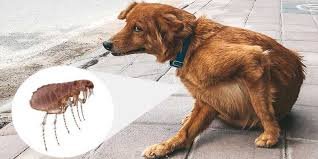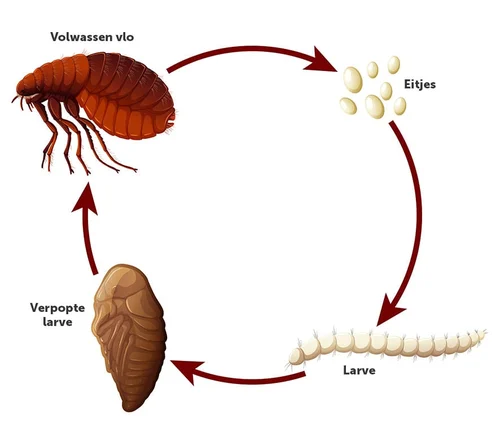Dog Fleas Treatment: A Complete Guide for Pet Owners

Fleas are more than just a nuisance for dogs—they can cause severe discomfort, allergic reactions, and transmit dangerous parasites. Understanding how to treat and prevent dog fleas is critical for your pet’s health and comforthttps://www.petmd.com/.
- Fleas can cause itching, redness, and hair loss.
- Dogs may develop flea allergy dermatitis from repeated bites.
- Fleas can transmit tapeworms and cause anemia in severe cases.
- Effective treatment involves your pet, your home, and your yard.
- Regular use of flea prevention products is essential for long-term control.
Why Dog Fleas Treatment is Important?
Flea Lifecycle

To effectively eliminate fleas, it’s important to understand their lifecycle:
| Stage | Description | Duration |
|---|---|---|
| Egg | Laid by adult fleas on the host, often fall off into surroundings | 2-10 days |
| Larva | Hatch from eggs and feed on organic matter and flea dirt | 5-20 days |
| Pupa | Cocooned stage; can survive dormant for months | 7-14 days (or longer) |
| Adult | Emerges to find a host and begin feeding | Lives up to 100 days on host |
Common Symptoms of Flea Infestation in Dogs: When You Need Dog Flea Treatment

Your dog may have fleas if you notice:
- Constant scratching or biting
- Red, irritated skin
- Black specks (flea dirt) on fur
- Flea eggs in bedding
- Hair loss or scabs on the skin
Step-by-Step Guide to Dog Fleas Treatment at Home
Start with Your Dog
- Bathe your dog with flea shampoo to kill adult fleas on contact.
- Use a flea comb for dog fleas treatment and eggs from the coat.
- Consult your veterinarian for dog fleas treatment
Clean the Home Environment
| Area | What to Do |
| Pet bedding | Wash in hot water weekly |
| Furniture & carpets | Vacuum daily and discard bags outside |
| Floors | Mop with pet-safe disinfectants |
| Cracks and corners | Use insect growth regulators (IGRs) to stop lifecycle |
Treatment Options for Dog Fleas
Topical Treatments
- Applied to the skin, usually between shoulder blades
- Kills fleas and prevents reinfestation for 30 days
- Examples: Advantage II, K9 Advantix II, Frontline Plus
Oral Medications for Dog Flea Treatment: Benefits and Application
- Chewable tablets that kill fleas from within the bloodstream
- Often effective within hours
- Options: Bravecto, NexGard, Simparica Trio
| Treatment Type | Pros | Cons |
| Topical | Easy to apply, long-lasting | May cause skin irritation |
| Oral | Fast-acting, no mess | Requires prescription, may cause side effects |
Flea Collars for Dog Flea Treatment: Effective Solutions for Long-Lasting Protection
- Provide continuous protection for up to 8 months for dog fleas treatment
- Brands like Seresto release active ingredients gradually
- Ideal for dogs who dislike topical or oral meds
Natural Remedies for dog fleas treatment
- Apple cider vinegar spray: May deter fleas
- Lemon juice rinse: Contains citrus that repels insects
- Essential oils: Use with caution and under vet guidance
Home and Yard Flea Control for Dog Flea Treatment: Effective Solutions to Prevent Reinfestation
Inside Your Home
- Vacuum regularly, especially under furniture and pet areas
- Steam clean carpets to kill eggs and larvae
- Use environmental sprays with IGRs for dog fleas treatment
- It will help you for dog fleas treatment.
Outdoor Control
| Yard Area | Action |
| Lawn | Keep grass trimmed short |
| Shaded areas | Spray with pet-safe flea treatments |
| Fence lines | Seal gaps to prevent wild animals (flea carriers) |
| Dog’s resting area | Use diatomaceous earth or cedar chips |
Preventive Measures for Future Flea Infestations: Keeping Your Dog Flea-Free
- Use monthly flea preventatives year-round
- Regularly check your dog for fleas, especially after outdoor walks
- Maintain home cleanliness and lawn care for dog fleas treatment
- Keep up with vet check-ups to adjust flea prevention plans as needed
- “One of the most common dog flea treatments is the use of topical treatments, which can be applied directly to your dog’s skin to kill fleas and prevent future infestations. These products are available in various forms, such as sprays and spot-on treatments. Additionally, oral medications provide an easy solution to eliminate fleas from within, offering long-lasting protection. Regular grooming with a dog flea comb also ensures that you can manually remove fleas and flea dirt, making it an important part of any comprehensive dog flea treatment plan.”
When to Seek Veterinary Help for Dog Flea Treatment: Expert Advice
Contact your vet if:
- Fleas return after multiple treatments
- Your dog shows signs of flea allergy dermatitis
- You notice unusual symptoms like lethargy or vomiting
- Home remedies fail to provide relief for dog fleas treatment
- Quick Solutions for Dog Flea Treatment: Bathing and Grooming Techniques to Remove Fleas
- Overview:
- When your dog has a flea infestation, quick action is crucial must move towards dog fleas treatment. Bathing and grooming are some of the fastest ways to help remove fleas and alleviate discomfort. Regular grooming not only helps remove fleas but also gives you the chance to spot any signs of reinfestation early. Here are some quick solutions for effective dog flea treatment:
- Bathing Techniques for Flea treatment:
- Flea Shampoos: Use specially formulated flea shampoos that kill fleas on contact. Make sure to follow the product’s instructions for optimal results.
- Warm Water: Bathe your dog in warm water to open the pores, allowing the flea shampoo to work more effectively.
- Thorough Rinsing: Rinse thoroughly to ensure no soap residue remains, as this could irritate your dog’s skin.
- Grooming to Remove Fleas:
- Flea Combs: Use a fine-toothed flea comb to comb through your dog’s fur. Dip the comb in soapy water to kill the fleas you remove.
- Focus on Flea-Prone Areas: Pay extra attention to areas where fleas are most likely to hide, such as behind the ears, near the tail, and in the underarms.
- By combining these methods, you can quickly reduce flea numbers and give your dog some much-needed relief.
Frequently Asked Questions
How do dogs get fleas?
Dogs can pick up fleas from other animals, infested homes, or outdoor areas like parks and yards. Wildlife like squirrels and raccoons can also carry fleas.
How long does it take to get rid of fleas?
With proper treatment, you can eliminate fleas within a few weeks. However, eggs and larvae may require 2-3 months of continuous treatment to fully break the lifecycle.
Are natural flea treatments effective?
Some natural remedies may repel fleas, but they are often less effective than vet-approved options. Use natural methods as a supplementary measure, not a replacement for dog fleas treatment and prevention
Can I treat my house without treating my dog?
No. Flea treatment must include both your pet and your environment. Skipping either step will result in reinfestation.
What is the safest flea treatment for puppies?
Always consult a vet. Products like Capstar or certain shampoos are approved for young puppies, but dosing and safety depend on the puppy’s age and weight.
How do I know if flea treatment is working?
Fleas will become less visible, your dog will stop scratching, and you’ll see fewer signs like flea dirt. Keep checking weekly to treat dog fleas.
Should I use flea prevention all year?
Yes. Fleas can survive indoors during winter, so year-round prevention is strongly recommended.
Final Thoughts: Consistent flea treatment for dogs is key to preventing infestation, ensuring comfort, and protecting your household. With a mix of effective flea medications, environmental management, and preventive care, your pet can remain healthy and flea-free all year long.
